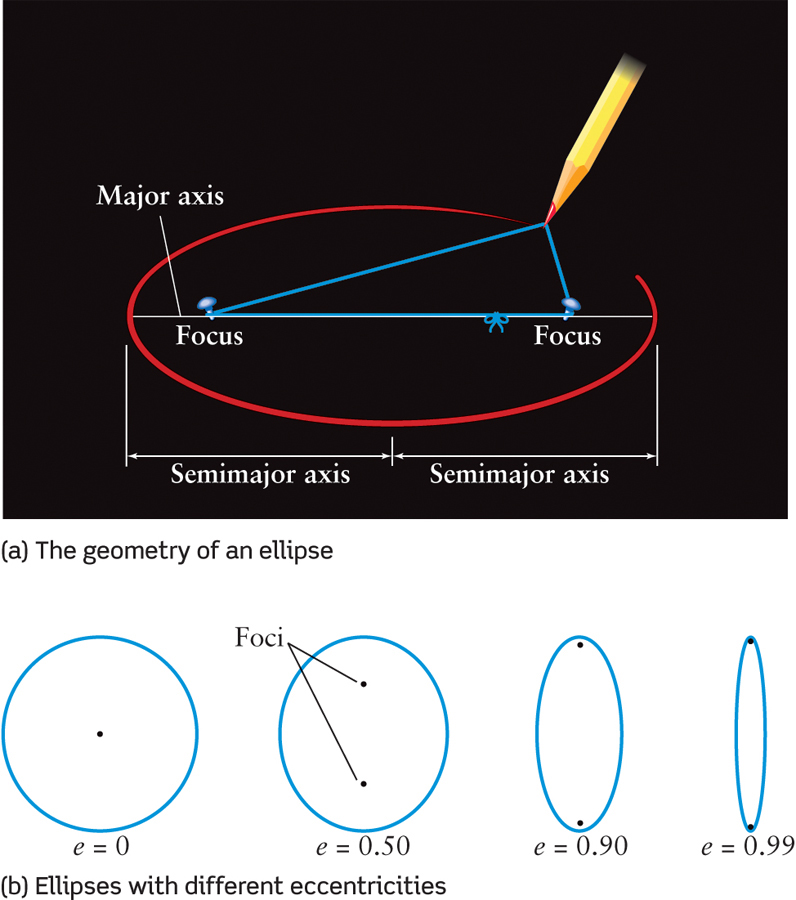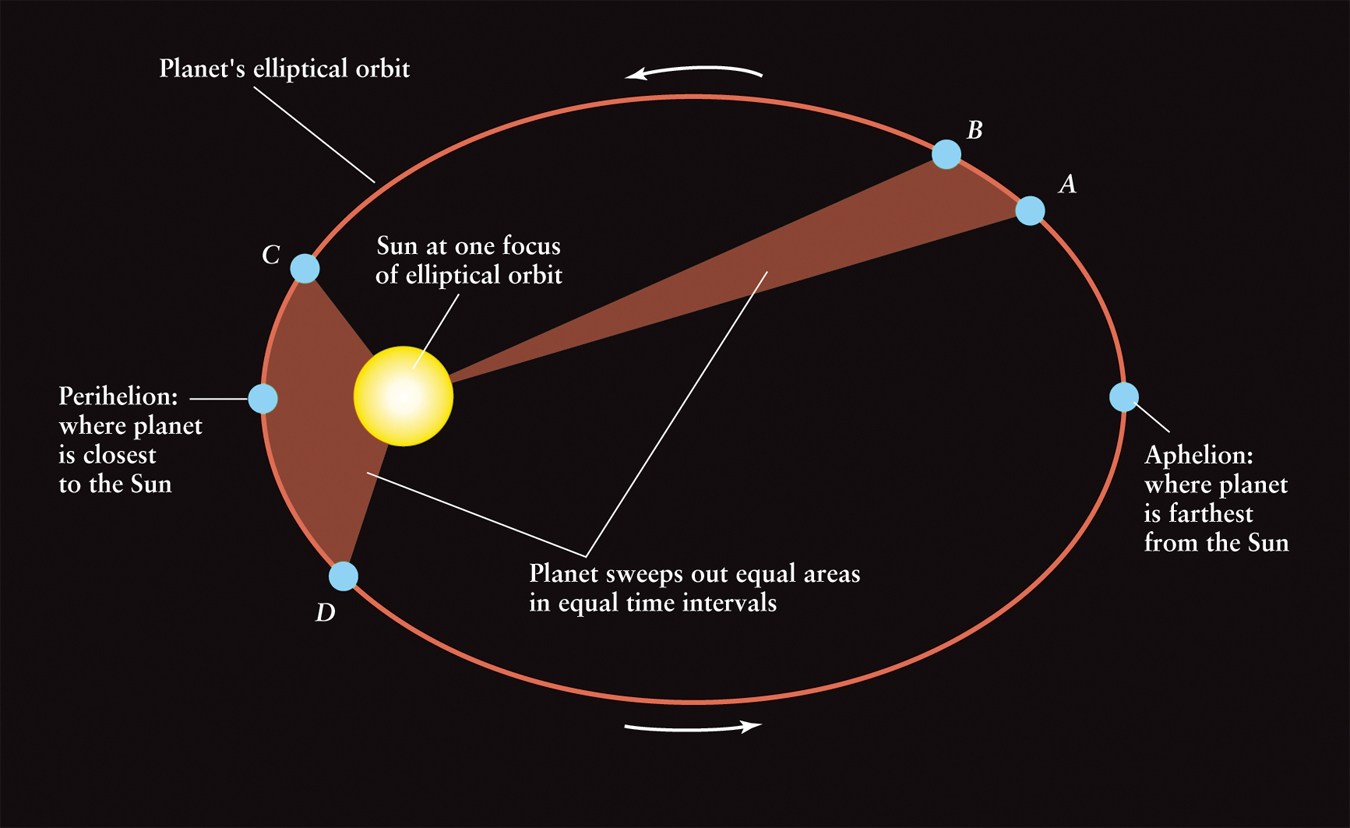3-4 Johannes Kepler proposed that planets orbit the Sun in elliptical paths, moving fastest when closest to the Sun, with the closest planets moving at the highest speeds
Astronomers had long assumed that heavenly objects move in circles, which were considered the most perfect and harmonious of all geometric shapes. Many believed that if a perfect God resided in heaven along with the stars and planets, then the motions of these objects must be perfect, too. At the beginning of the seventeenth century, and against this context, Johannes Kepler took on the task of finding a model of planetary motion that agreed precisely with the observed positions of planets.
Elliptical Orbits and Kepler’s First Law
Kepler was a mathematician and had the unique benefit of access to incredibly precise planetary position data, collected by an eccentric Danish nobleman named Tycho Brahe. Using this data, Kepler dared to try to explain planetary motions with imperfect circles. In particular, he found that he had the best success with a particular shape called an ellipse.
You can draw an ellipse by using a loop of string, two thumbtacks, and a pencil, as shown in Figure 3-14a. Each thumbtack in the figure is at a focus (plural foci) of the ellipse; an ellipse has two foci. The longest diameter of an ellipse, called the major axis, passes through both foci. Half of that distance is called the semimajor axis and is usually designated by the letter a. Another way to think about the distance a is as being the average distance between the edge and a focus point. (A circle is a special case of an ellipse in which the two foci are at the same point. This corresponds to using only a single thumbtack in Figure 3-14a). The semimajor axis, a, of a circle is equal to its radius.

By assuming that planetary orbits are ellipses, Kepler found, to his delight, that he could make his theoretical calculations match precisely to observations. This important discovery, first published in 1609, is now called Kepler’s first law:
The orbit of a planet about the Sun is an ellipse with the Sun at one focus.
The semimajor axis a of a planet’s orbit is the average distance between the planet and the Sun.
75
CAUTION
The Sun is at one focus of a planet’s elliptical orbit, but there is nothing at the other focus. This “empty focus” has geometrical significance because it helps to define the shape of the ellipse, but it plays no other role.
Ellipses come in different shapes, depending on the elongation of the ellipse. The shape of an ellipse is described by its eccentricity, designated by the letter e. The value of e can range from 0 (a circle) to just under 1 (nearly a straight line). The greater the eccentricity, the more elongated the ellipse. Figure 3-14b shows a few examples of ellipses with different eccentricities. Because a circle is a special case of an ellipse, it is possible to have a perfectly circular orbit. But all of the objects that orbit the Sun have orbits that are at least slightly elliptical. The most circular of any planetary orbit is that of Venus, with an eccentricity of just 0.007; Mercury’s orbit has an eccentricity of 0.206, and a number of small bodies called comets move in very elongated orbits with eccentricities just less than 1.
Question
ConceptCheck 3-13: Which orbit is more circlelike—Venus’s orbit, with e = 0.007, or Mars’s orbit, with e= 0.093?
Orbital Speeds and Kepler’s Second Law
Once Kepler knew the shape of a planet’s orbit, he was ready to describe exactly how it moves on that orbit. As a planet travels in an elliptical orbit, its distance from the Sun varies. Kepler realized that the speed of a planet also varies along its orbit. A planet moves most rapidly when it is nearest the Sun, at a point on its orbit called perihelion. Conversely, a planet moves most slowly when it is farthest from the Sun, at a point called aphelion (Figure 3-15).

After much trial and error, Kepler found a way to describe just how a planet’s speed varies as it moves along its orbit. Figure 3-15 illustrates this discovery, also published in 1609. Suppose that it takes 30 days for a planet to go from point A to point B. During that time, an imaginary line joining the Sun and the planet sweeps out a nearly triangular area. Kepler discovered that a line joining the Sun and the planet also sweeps out exactly the same area during any other 30-day interval. In other words, if the planet also takes 30 days to go from point C to point D, then the two shaded segments in Figure 3-15 are equal in area. Kepler’s second law can be stated in this way:
A line joining a planet and the Sun sweeps out equal areas in equal intervals of time.
This relationship is also called the law of equal areas. In the idealized case of a circular orbit, a planet would have to move at a constant speed around the orbit in order to satisfy Kepler’s second law.
Kepler’s laws explain equally well the orbits of planets around the Sun, moons around their own planets, and man-made satellites around Earth.
ANALOGY
An analogy for Kepler’s second law is a twirling ice skater holding weights in each hand. If the skater moves the weights closer to her body by pulling her arms straight in, her rate of spin increases and the weights move faster; if she extends her arms so the weights move away from her body, her rate of spin decreases and the weights slow down. Just like the weights, a planet in an elliptical orbit travels at a higher speed when it moves closer to the Sun (toward perihelion) and travels at a lower speed when it moves away from the Sun (toward aphelion).
Question
ConceptCheck 3-14: According to Kepler’s second law, at what point in a communications satellite’s orbit around Earth will it move the slowest?
76
Orbital Periods and Kepler’s Third Law
Kepler’s second law describes how the speed of a given planet changes as it orbits the Sun. Kepler also deduced a relationship that can be used to compare the motions of different planets. Published later than his first two propositions and now called Kepler’s third law, it states a relationship between the size of a planet’s orbit and the time the planet takes to go once around the Sun:
The square of the sidereal period of a planet is directly proportional to the cube of the semimajor axis of the orbit.
Kepler’s third law says that the larger a planet’s orbit—that is, the larger the semimajor axis, or average distance from the planet to the Sun—the longer the sidereal period, which is the time it takes the planet to complete an orbit. From Kepler’s third law one can show that the larger the semimajor axis, the slower the average speed at which the planet moves around its orbit. (By contrast, Kepler’s second law describes how the speed of a given planet is sometimes faster and sometimes slower than its average speed.) This qualitative relationship between orbital size and orbital speed is just what Aristarchus and Copernicus used to explain retrograde motion. Kepler’s great contribution was to make this relationship a quantitative one.
It is useful to restate Kepler’s third law as an equation. If a planet’s sidereal period P is measured in years and the length of its semimajor axis a is measured in astronomical units (AU), where 1 AU is the average distance from Earth to the Sun, then Kepler’s third law is
Kepler’s third law
P2 = a3

We can verify Kepler’s third law for all of the planets, including those that were discovered after Kepler’s death, using data from Table 3-1. If Kepler’s third law is correct, for each planet the numerical values of P2 and a3 should be equal. This is indeed true to very high accuracy, as Table 3-2 shows.
| Planet | Sidereal Period P (years) | Semimajor axis a (AU) | P2 | a3 |
|---|---|---|---|---|
| Mercury | 0.24 | 0.39 | 0.06 | 0.06 |
| Venus | 0.61 | 0.72 | 0.37 | 0.37 |
| Earth | 1.00 | 1.00 | 1.00 | 1.00 |
| Mars | 1.88 | 1.52 | 3.53 | 3.51 |
| Jupiter | 11.86 | 5.20 | 140.70 | 140.60 |
| Saturn | 29.46 | 9.55 | 867.90 | 871.00 |
| Uranus | 84.10 | 19.19 | 7,072.00 | 7,067.00 |
| Neptune | 164.86 | 30.07 | 27,180.00 | 27,190.00 |
| Kepler’s third law states that P2 = a3 for each of the planets. The last two columns of this table demonstrate that this relationship holds true to a very high level of accuracy. | ||||
Question
ConceptCheck 3-15: The space shuttle typically orbited Earth at an altitude of 300 km whereas the International Space Station orbits Earth at a higher altitude of 370 km. Although the space shuttle took less time to orbit Earth, which one actually moved at a faster rate?
Question
CalculationCheck 3-2: if Pluto’s orbit has a semimajor axis of 39.5 AU, how long does it take Pluto to orbit the Sun once?
The Significance of Kepler’s Laws
 Go to Video 3-3
Go to Video 3-3
Kepler’s laws are a landmark in the history of astronomy. They made it possible to calculate the motions of the planets with better accuracy than any geocentric model ever had, and they helped to justify the idea of a Sun-centered model. Kepler’s laws also pass the test of Occam’s razor, for they are simpler in every way than the schemes of Ptolemy or Copernicus, both of which used a complicated combination of circles.
But the significance of Kepler’s laws goes far beyond understanding planetary orbits. These same laws are also obeyed by spacecraft orbiting Earth, by two stars revolving about each other in a binary star system, and even by galaxies in their orbits about each other. Throughout this book, we will use Kepler’s laws in a wide range of situations.
As impressive as Kepler’s mathematical accomplishments were in describing when planets could be found where in the sky, he did not prove that the planets orbit the Sun, nor was he able to explain why planets move in accordance with his three laws. While we attribute the demonstration that planets orbit the Sun to Galileo, who worked independently from Kepler, Isaac Newton is credited as the luminary who figured out that gravity was responsible for why the planets move as they do.
77
Question
ConceptCheck 3-16: Do Kepler’s laws of planetary motion apply only to the planets?